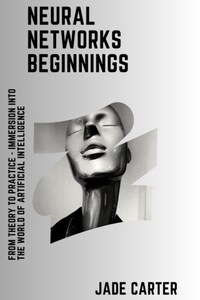Neural networks are computer systems that attempt to imitate the functioning of the human brain. They consist of neurons that are connected and process information by transmitting it through neural connections. Each neuron performs a simple function, but together they can process complex tasks.
Neural networks are important because they allow us to solve tasks that were previously impossible or very difficult to solve using traditional programming methods. They are used in various fields, including image and sound processing, speech recognition, economic trend forecasting, production process management, and much more.
Currently, neural networks are one of the key components of machine learning and artificial intelligence. They can be trained on large amounts of data and gradually improve their results, making them very useful for solving tasks that were previously inaccessible for automation.
The goal of this book is to introduce the reader to the basics of neural networks, starting with simple concepts and methods and ending with more complex topics. In the book, you will learn how neurons work, how to train neural networks, how to choose the appropriate neural network for a particular task, and how to apply neural networks to solve classification, regression, and clustering tasks.
The book is aimed at beginners and does not require any prior knowledge in the field of machine learning. It provides the reader with a complete practical guide to working with neural networks, which will help to start applying them in their own projects. By reading the book, you will acquire the necessary knowledge and practical skills for working with neural networks, as well as learn about the latest trends and developments in this field.
Our book will help you to:
Understand how neural networks work and what tasks they can solve;
Learn about various types of neural networks and choose the most suitable one for a particular task;
Learn how to create and train neural networks using different libraries and tools;
Master techniques for working with data, preparing data, and selecting the most appropriate model parameters to achieve the best results;
Learn about the application of neural networks in various fields such as image processing, speech recognition, text analysis, forecasting, and more;
Gain practical skills in working with neural networks through examples that can be applied in real projects.
In this book, we will focus on a practical approach and provide numerous examples and tasks that will help you better understand and absorb the material. You will learn how to create neural networks from scratch, train them on real data, and evaluate their results. We will also provide a wealth of resources and links to help you continue your learning and development in this field.
We are confident that this book will be useful for anyone interested in neural networks, machine learning, and artificial intelligence. Whether you are a student, IT professional, or simply a technology enthusiast, you will find a lot of useful information and practical skills in this book. Let's begin our journey into the world of neural networks!
Chapter 1: Basics of Neural Networks
Neural networks are a powerful tool in the field of artificial intelligence and machine learning. They are used in many applications, such as speech recognition, image processing, and forecasting. However, to understand how a neural network works, one must start with the basics.
The basic unit of a neural network is a neuron. A neuron is a simple information processing unit that mimics the function of a nerve cell in our brain. A neuron receives input signals from other neurons and generates an output signal that is passed on to other neurons.
Each neuron in a neural network has weights and biases. Weights determine how important each input signal is to the neuron's function, while biases are added to the sum of the input signals to make the neuron more flexible and enable it to make decisions based on a wider range of input data.
When a neuron receives input data, it multiplies the inputs by the weights and adds the bias. It then applies an activation function, which determines whether the neuron should activate and pass on the signal further through the network. The activation function can vary depending on the task the neural network is designed to perform. For example, the activation function can be sigmoid, hyperbolic tangent, ReLU (Rectified Linear Unit), and many others.
Neural networks are a powerful tool in the field of artificial intelligence and machine learning. They are used in many applications such as speech recognition, image processing, and prediction. However, to understand how a neural network works, we need to start with the basics.
The foundation of a neural network is a neuron. A neuron is a simple unit of information processing that mimics the function of a nerve cell in our brain. A neuron receives input signals from other neurons and generates an output signal that is passed on to other neurons.








